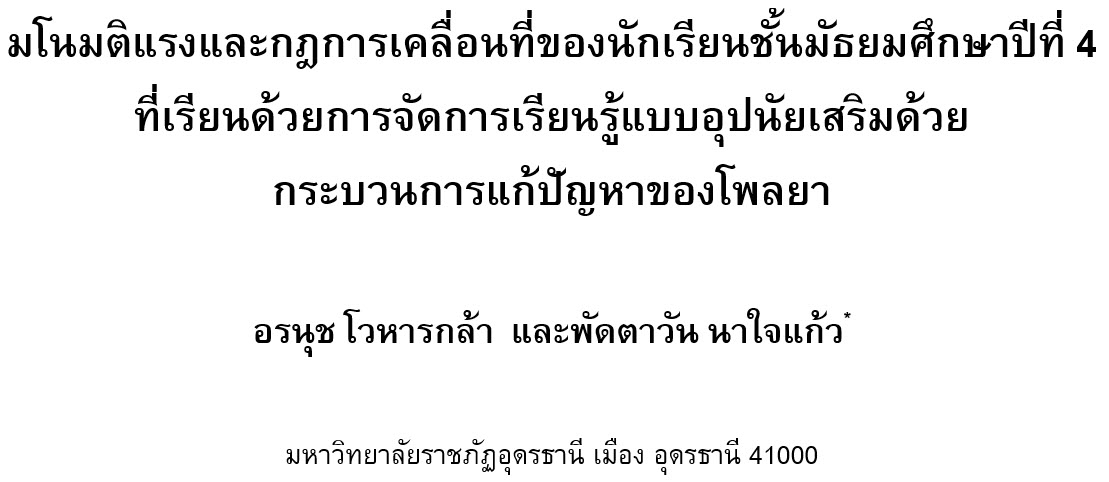มโนมติแรงและกฎการเคลื่อนที่ของนักเรียนชั้นมัธยมศึกษาปีที่ 4 ที่เรียนด้วยการจัดการเรียนรู้แบบอุปนัยเสริมด้วย
Main Article Content
Abstract
Force and Motion Conception of Grade 10 Students Learning through Inductive Instructional Model Supplemented with Polya’s Problem Solving Process
Oranood Wohankla and Pattawan Narjaikaew
รับบทความ: 7 กุมภาพันธ์ 2561; ยอมรับตีพิมพ์: 16 พฤษภาคม 2561
บทคัดย่อ
การวิจัยในครั้งนี้มีวัตถุประสงค์เพื่อศึกษาเปรียบเทียบมโนมติแรงและกฎการเคลื่อนของนัก-เรียนชั้นมัธยมศึกษาปีที 4 การวิจัยนี้ใช้รูปแบบการวิจัยเชิงแบบกลุ่มเดียวทดสอบก่อนเรียนและหลังเรียน กลุ่มตัวอย่างที่ใช้ในการวิจัยเป็นนักเรียนชั้นมัธยมศึกษาปีที่ 4 จำนวน 1 ห้องเรียน จำนวน 42 คน ภาคเรียนที่ 1 ปีการศึกษา 2559 ที่ได้จากการสุ่มตัวอย่างแบบกลุ่ม เครื่องมือที่ใช้ในการวิจัยประกอบด้วยแผนการจัดการแบบอุปนัยเสริมด้วยกระบวนการแก้ปัญหาของโพลยา จำนวน 9 แผน แบบทดสอบวัดมโนมติแรงและกฎการเคลื่อนที่ซึ่งเป็นข้อสอบแบบตัวเลือก 2 ลำดับขั้น วิเคราะห์โดยใช้เกณฑ์ของ Costu et al. (2012) วิเคราะห์ข้อมูลเชิงปริมาณใช้ค่าเฉลี่ย ความถี่ ร้อยละ ส่วนเบี่ยง-เบนมาตรฐาน การทดสอบทีแบบไม่อิสระ การทดสอบของ McNemar และการวิเคราะห์เชิงคุณภาพด้วยเทคนิคการวิเคราะห์เนื้อหา ผลการวิจัยพบว่านักเรียนมีมโนมติแรงและการเคลื่อนที่หลังเรียน (mean = 27.69 หรือ 92.30%) สูงกว่าก่อนเรียน (mean = 5.69 หรือ18.97%) โดยหลังเรียนนักเรียนมีความเข้าใจมโนมติแรงและการเคลื่อนที่ที่ความเข้าใจสมบูรณ์ (SU) และความเข้าใจบางส่วน (PU) เพิ่มขึ้น และมีความเข้าใจคลาดเคลื่อน (SM) และไม่เข้าใจ (NU) ลดลงกว่าก่อนเรียน
คำสำคัญ: มโนมติแรงและการเคลื่อนที่ วิธีการสอนแบบอุปนัย กระบวนการแก้ปัญหาของโพลยา ความสามารถในการคิดแก้ปัญหา
Abstract
The purposes of this research were to compare force and motion concept of Matthayomsuksa 4 (grade 10) students. The study was conducted by one–group pretest–posttest design. The samples were 42 grade 10 students in the 1st semester of academic year 2016. A classroom was selected by cluster random sampling technique. The research instruments were 9 lesson plans based on the inductive teaching model supplemented with Polya’s problem–solving process, and a two–tier diagnostic test. The student responses to each two–tier test item were categorized following criteria used by Costu et al. (2012). The quantitative data were analyzed by using mean, frequency, percentage, standard deviation, t–test for dependent samples, and McNemar's test for significance of change. In addition, content analysis was used for qualitative data. The findings of the study found that after learning, they showed understanding of force and motion concepts (mean = 27.69 or 92.30%) higher than before learning (mean =5.69 or 18.97%). In addition, they showed an increase in sound understanding (SU) and partial understanding (PU) of force and motion concepts, whereas they showed a decreased in the specific misconception (SM) and no understanding (NU).
Keywords: Force and motion concept, Inductive teaching model, Polya’s problem–solving process, Problem–solving thinking ability
Oranood Wohankla and Pattawan Narjaikaew
รับบทความ: 7 กุมภาพันธ์ 2561; ยอมรับตีพิมพ์: 16 พฤษภาคม 2561
บทคัดย่อ
การวิจัยในครั้งนี้มีวัตถุประสงค์เพื่อศึกษาเปรียบเทียบมโนมติแรงและกฎการเคลื่อนของนัก-เรียนชั้นมัธยมศึกษาปีที 4 การวิจัยนี้ใช้รูปแบบการวิจัยเชิงแบบกลุ่มเดียวทดสอบก่อนเรียนและหลังเรียน กลุ่มตัวอย่างที่ใช้ในการวิจัยเป็นนักเรียนชั้นมัธยมศึกษาปีที่ 4 จำนวน 1 ห้องเรียน จำนวน 42 คน ภาคเรียนที่ 1 ปีการศึกษา 2559 ที่ได้จากการสุ่มตัวอย่างแบบกลุ่ม เครื่องมือที่ใช้ในการวิจัยประกอบด้วยแผนการจัดการแบบอุปนัยเสริมด้วยกระบวนการแก้ปัญหาของโพลยา จำนวน 9 แผน แบบทดสอบวัดมโนมติแรงและกฎการเคลื่อนที่ซึ่งเป็นข้อสอบแบบตัวเลือก 2 ลำดับขั้น วิเคราะห์โดยใช้เกณฑ์ของ Costu et al. (2012) วิเคราะห์ข้อมูลเชิงปริมาณใช้ค่าเฉลี่ย ความถี่ ร้อยละ ส่วนเบี่ยง-เบนมาตรฐาน การทดสอบทีแบบไม่อิสระ การทดสอบของ McNemar และการวิเคราะห์เชิงคุณภาพด้วยเทคนิคการวิเคราะห์เนื้อหา ผลการวิจัยพบว่านักเรียนมีมโนมติแรงและการเคลื่อนที่หลังเรียน (mean = 27.69 หรือ 92.30%) สูงกว่าก่อนเรียน (mean = 5.69 หรือ18.97%) โดยหลังเรียนนักเรียนมีความเข้าใจมโนมติแรงและการเคลื่อนที่ที่ความเข้าใจสมบูรณ์ (SU) และความเข้าใจบางส่วน (PU) เพิ่มขึ้น และมีความเข้าใจคลาดเคลื่อน (SM) และไม่เข้าใจ (NU) ลดลงกว่าก่อนเรียน
คำสำคัญ: มโนมติแรงและการเคลื่อนที่ วิธีการสอนแบบอุปนัย กระบวนการแก้ปัญหาของโพลยา ความสามารถในการคิดแก้ปัญหา
Abstract
The purposes of this research were to compare force and motion concept of Matthayomsuksa 4 (grade 10) students. The study was conducted by one–group pretest–posttest design. The samples were 42 grade 10 students in the 1st semester of academic year 2016. A classroom was selected by cluster random sampling technique. The research instruments were 9 lesson plans based on the inductive teaching model supplemented with Polya’s problem–solving process, and a two–tier diagnostic test. The student responses to each two–tier test item were categorized following criteria used by Costu et al. (2012). The quantitative data were analyzed by using mean, frequency, percentage, standard deviation, t–test for dependent samples, and McNemar's test for significance of change. In addition, content analysis was used for qualitative data. The findings of the study found that after learning, they showed understanding of force and motion concepts (mean = 27.69 or 92.30%) higher than before learning (mean =5.69 or 18.97%). In addition, they showed an increase in sound understanding (SU) and partial understanding (PU) of force and motion concepts, whereas they showed a decreased in the specific misconception (SM) and no understanding (NU).
Keywords: Force and motion concept, Inductive teaching model, Polya’s problem–solving process, Problem–solving thinking ability
Downloads
Download data is not yet available.
Article Details
How to Cite
Wohankla, O., & Narjaikaew, P. (2018). มโนมติแรงและกฎการเคลื่อนที่ของนักเรียนชั้นมัธยมศึกษาปีที่ 4 ที่เรียนด้วยการจัดการเรียนรู้แบบอุปนัยเสริมด้วย. วารสารหน่วยวิจัยวิทยาศาสตร์ เทคโนโลยี และสิ่งแวดล้อมเพื่อการเรียนรู้ (Journal of Research Unit on Science, Technology and Environment for Learning), 9(1), 76–92. https://doi.org/10.14456/jstel.2018.7
Section
บทความวิจัย (Research Article)

This work is licensed under a Creative Commons Attribution-NonCommercial 4.0 International License.
